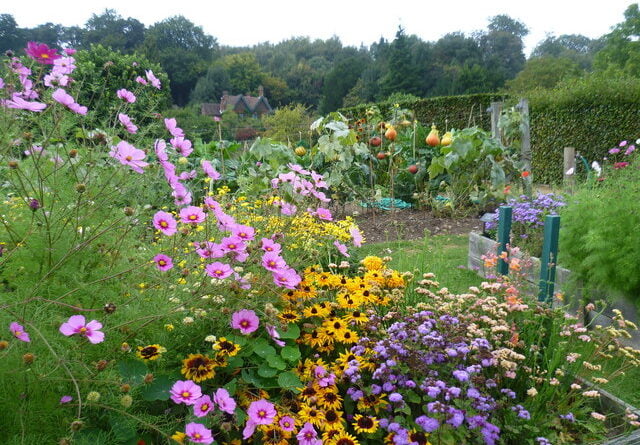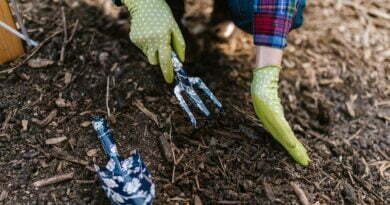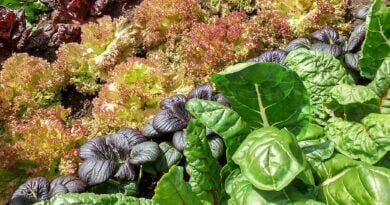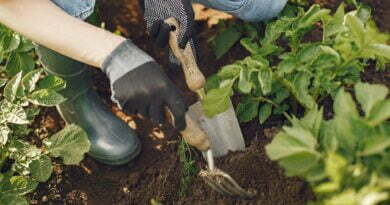Creating a Beautiful and Productive Allotment Garden: Tips and Tricks
When it comes to designing an allotment garden, there are numerous factors to consider to achieve a balance between productivity and aesthetics. An allotment garden should not only yield a bountiful harvest but also serve as a pleasant and inviting space where you can enjoy spending your time. From planning the layout and selecting the right plants to incorporating decorative elements and sustainable practices, creating a garden that is both functional and visually appealing requires thoughtful planning and execution. In this post, we’ll delve into various tips and advice on how to design your allotment garden to maximise both productivity and aesthetics, ensuring that your gardening experience is both fruitful and enjoyable. Whether you are a seasoned gardener or a novice, these insights will help you transform your allotment into a beautiful and productive haven.

- Choose the Right Layout
The first step in designing your allotment garden is to choose the right layout. The layout you select will depend on the amount of space available and your personal preferences, as well as the types of plants you wish to grow. Several popular garden layouts include rows, raised beds, and containers, each offering unique advantages and considerations.
Rows are a traditional and widely used layout for allotment gardens. In this design, crops are planted in long, straight rows with pathways in between to allow easy access for planting, watering, weeding, and harvesting. This method is particularly effective for larger allotments and for growing crops in bulk. It allows for efficient use of space and is ideal for mechanised tools like tillers or hoes. However, row planting can lead to soil compaction in the pathways and may require more extensive weeding and maintenance.
When choosing the layout for your allotment garden, consider the specific needs of the plants you wish to grow and the amount of time and effort you can dedicate to maintenance. Each layout offers distinct benefits and challenges, so it’s essential to select one that aligns with your gardening goals and lifestyle.
The first step in designing your allotment garden is to choose the right layout. Whether you opt for traditional rows, raised beds, or containers, your choice will influence the functionality and aesthetics of your garden. By carefully considering the available space, your personal preferences, and the needs of your plants, you can create a productive and enjoyable allotment garden that suits your unique requirements.
- Use Crop Rotation and Companion Planting
One of the most crucial aspects of designing an allotment garden is implementing crop rotation and companion planting strategies. These methods not only enhance the health and productivity of your garden but also contribute to sustainable gardening practices.
Crop rotation involves systematically changing the types of crops planted in specific areas of your garden each year. This practice helps prevent the build-up of soil-borne diseases and pests that can occur when the same crop is grown in the same spot repeatedly. By rotating crops, you disrupt the life cycles of pests and diseases, reducing their chances of establishing a foothold in your garden. Additionally, crop rotation helps maintain soil fertility by alternating crops that deplete certain nutrients with those that replenish them. For instance, planting nitrogen-fixing legumes like peas or beans after heavy feeders like tomatoes or corn can naturally enhance soil fertility.
By integrating crop rotation and companion planting into your allotment garden design, you can create a more resilient and productive garden ecosystem. These practices not only contribute to healthier plants and higher yields but also promote biodiversity and ecological balance. Whether you are growing vegetables, herbs, or flowers, understanding and applying these techniques will help you cultivate a flourishing and sustainable garden.
- Use Raised Beds and Containers
Raised beds and containers are excellent strategies for maximising space and enhancing drainage in your allotment garden. These methods not only improve the organisation and aesthetics of your garden but also offer practical benefits, particularly for those with limited mobility, as they can be elevated to a more comfortable working height.
Raised beds allow you to create defined, manageable sections in your allotment, which can be tailored to the specific needs of the plants you wish to grow. The elevation improves drainage, preventing waterlogging and reducing the risk of soil-borne diseases. Additionally, the soil in raised beds tends to warm up faster in the spring and retain heat longer into the autumn, extending your growing season. This can be particularly beneficial in the UK’s variable climate. When designing your raised beds, consider the size carefully. Beds that are too wide can make it difficult to reach the centre without stepping on the soil, which can compact it and hinder plant growth. A width of around 1.2 metres (4 feet) is typically ideal, allowing easy access from both sides. The length can vary according to your space and preference, but longer beds should have pathways to ensure easy access to all areas.
Containers offer similar benefits and are particularly useful in small or awkwardly shaped spaces where traditional garden beds may not be feasible. They can be moved around to take advantage of the best light conditions and can be grouped together to create microclimates that support plant growth. When choosing containers, it is crucial to ensure they are large enough to accommodate the mature size of the plants. Root-bound plants can struggle to thrive, so providing adequate space is essential. Containers should also have sufficient drainage holes to prevent waterlogging. Adding a layer of gravel or broken pottery at the bottom of the container before adding soil can further improve drainage.
Both raised beds and containers can be customised in height to suit your needs, making gardening more accessible for those who have difficulty bending or kneeling. A height of around 60-90 cm (24-36 inches) is generally comfortable for most people. This adaptability makes them an excellent choice for elderly gardeners or those with physical limitations, allowing them to enjoy gardening without unnecessary strain.
When planning your raised beds and containers, consider using high-quality soil and compost. These will provide the necessary nutrients and structure to support healthy plant growth. You may also want to incorporate organic matter such as well-rotted manure or leaf mould to improve soil fertility and moisture retention.
Incorporating raised beds and containers into your allotment garden design offers numerous advantages. These methods not only help maximise space and improve drainage but also make gardening more accessible and enjoyable. By carefully selecting the size and materials for your beds and containers, and ensuring they have adequate drainage, you can create a productive and visually appealing garden that suits your needs and enhances your gardening experience.

- Incorporate Decorative Elements
In addition to being productive, your allotment garden can also be a beautiful space where you enjoy spending time. Incorporating decorative elements such as trellises, garden art, and decorative containers can add visual interest and personal flair to your garden, making it both functional and aesthetically pleasing. However, it’s important to strike a balance to ensure that these additions do not interfere with the practical aspects of your gardening efforts.
Trellises are a wonderful way to add vertical interest and support climbing plants like beans, peas, and cucumbers. They not only maximise your growing space by allowing plants to grow upwards but also create charming visual focal points. Consider using trellises in different shapes and materials to complement the overall design of your allotment. Rustic wooden trellises can blend seamlessly into a natural garden setting, while metal or painted wooden trellises can add a touch of elegance and colour.
Garden art is another fantastic way to personalise your allotment. From whimsical sculptures and colourful garden stakes to birdbaths and wind chimes, these elements can bring a sense of fun and creativity to your space. When choosing garden art, consider pieces that reflect your personality and interests, and position them in spots where they won’t obstruct pathways or overshadow your plants. Subtle, well-placed pieces can enhance the overall atmosphere of your garden without detracting from its functionality.
Decorative containers are a versatile way to introduce colour and texture to your allotment. They can be used to grow a variety of plants, from vibrant flowers and herbs to small shrubs and vegetables. When selecting containers, think about the materials and colours that will best complement your garden’s aesthetic. Terra cotta pots offer a classic, earthy look, while brightly coloured or patterned containers can create striking contrasts. Additionally, repurposing old items like barrels, buckets, or even wellies can add a unique, eco-friendly touch to your garden.
Creating a beautiful and productive allotment garden is entirely achievable with thoughtful planning and design. By incorporating decorative elements like trellises, garden art, and decorative containers, you can enhance the visual appeal of your garden while maintaining its functionality. Remember to strike a balance and ensure that your decorative choices complement rather than compromise the practical aspects of your gardening. With a harmonious blend of productivity and beauty, your allotment can become a delightful sanctuary that brings you joy and satisfaction throughout the gardening season.
- Create Functional Pathways
It’s important to create functional pathways that make it easy to navigate your allotment garden. Well-designed pathways are crucial for accessibility, ensuring you can move comfortably between different sections of your garden without disturbing your plants. When planning your pathways, consider their width and the materials you will use to construct them.
First, make sure your pathways are wide enough to allow for easy movement. A minimum width of 60 cm (about 24 inches) is generally recommended, but if you frequently use wheelbarrows or gardening carts, you might want to make them even wider. This additional space ensures you can comfortably walk through your garden, transport tools and supplies, and access your plants for maintenance and harvesting.
Choosing the right materials for your pathways is also essential. Materials like gravel and wood chips are excellent options as they provide good drainage and help to reduce mud, keeping your pathways dry and navigable even after rain. Gravel is particularly durable and easy to maintain, creating a firm surface that prevents weed growth. Wood chips, on the other hand, offer a more natural and softer look, blending seamlessly with the garden environment. They also decompose over time, adding organic matter to the soil, which can be beneficial for your garden’s ecosystem.
In addition to gravel and wood chips, you might also consider using stepping stones, bricks, or pavers. These materials can add a decorative element to your garden while creating sturdy and clean pathways. When placing stepping stones or pavers, ensure they are level and secure to prevent tripping hazards. You can also combine these materials with gravel or wood chips for a more textured and visually appealing path.
Moreover, think about the layout of your pathways in relation to your garden’s overall design. Curved paths can add a sense of flow and natural movement, while straight paths provide a more formal and structured appearance. Whatever layout you choose, make sure the pathways lead to all key areas of your garden, including planting beds, compost bins, and water sources, to ensure ease of access.
Functional pathways are a vital component of an efficient and enjoyable allotment garden. By making your pathways wide enough for comfortable movement and using materials like gravel or wood chips to improve drainage and reduce mud, you can create a garden that is both accessible and visually appealing. Thoughtfully designed pathways not only enhance the practicality of your garden but also contribute to its overall charm and functionality, making your gardening experience more pleasant and productive.

Designing an allotment garden that is both productive and beautiful can be a challenging but rewarding task. By choosing the right layout, using crop rotation and companion planting, incorporating raised beds and containers, adding decorative elements, and creating functional pathways, you can create an allotment garden that not only provides you with a bountiful harvest but also adds visual interest to your outdoor space.
Remember, gardening is an ongoing process, and it’s important to experiment and try new things to see what works best for your garden. By taking the time to design and plan your allotment garden, you can create a space that brings you joy and satisfaction throughout the growing season and beyond.
Whether you’re a seasoned gardener or just starting out, don’t be afraid to get creative with your allotment garden design. With a little bit of effort and some thoughtful planning, you can create a beautiful and productive garden that will provide you with fresh, healthy produce and a beautiful outdoor space to enjoy. Happy gardening!




